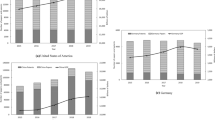Abstract
Nine SPT-1 and SPT-2 type two conductor energized appliance power cords were exposed to radiant heat and to flames in the presence and absence of combustible materials. The power cords consisted of integral and non-integral insulated multistranded 18 AWG copper conductors. The objectives of exposing these power cords to radiant heat and flame are to: evaluate the performance of the power cords in fire environments, and characterize the electrical activity and material damage sustained by the power cords. Data was recorded for 713 power cords tested under six different conditions. Not all of the power cords tested showed evidence of electrical fault activity. However, each power cord exposed to a radiant heat flux of 40 kW/m2 in the presence of combustible material exhibited signs of electrical fault activity. Damage to the copper conductors varied from localized fusing to complete severance. Power cords exposed to a radiant heat flux of 40 kW/m2 in the absence of combustibles did not always exhibit signs of electrical fault activity. Test data did not show any significant correlations among types of power cord damage/electrical activity and fire conditions.
Similar content being viewed by others
References
B.V. Etting, “Electrical Wiring in Building Fires,” Fire Technology, vol. 14, no. 4, 1978, p. 317.
B. Beland, “Examination of Electrical Conductors Following a Fire,” Fire Technology, vol. 16, no. 4, 1980, p. 252.
National Bureau of Standards, Fire Investigation Handbook, PE 81-113482, R.G. Bright and J. Norah, eds., U.S. Department of Commerce, 1980.
R.C. MacCleary, and R.N. Thaman, “Methods for Use in Fire Investigation,” United States Patent, Patent Number 4,182,959, 1980.
Interview: “Did the Short Cause the Fire or Did the Fire Cause the Short,” Fire and Arson Investigator, vol. 30, no. 1, 1979, p. 57.
R.N. Anderson, “Surface Analysis of Electrical Arc Residues in Fire Investigation,” Journal of Forensic Science, vol. 34, no. 3, 1989, p. 633.
R.N. Anderson, “Which Came First the Arcing or the Fire, A Review of Auger Analysis of Electrical Arc Residues,” Fire and Arson Investigator, March 1996, p. 38.
D.G. Howitt, “The Surface Analysis of Copper Arc Beads—A Critical Review,” Journal of Forensic Science, vol. 42, no. 4, 1997, p. 608.
R. Henderson, C. Manning, and S. Barnhill, “Questions Concerning the Use of Carbon Content to Identify ‘Cause’ vs. ‘Result’ Beads in Fire Investigations,” Fire and Arson Investigator, vol. 48, no. 3, 1998, p. 26.
B. Beland, “Examination of Arc Beads,” Fire and Arson Investigator, vol. 44, no. 4, 1994, p. 20.
M. Delplace, and E. Vos, “Electric Short Circuits Help the Investigator Determine Where the Fire Started,” Fire Technology, vol. 19, no. 3, 1983, p. 185.
D.A. Gray, D.D. Drysdale, and F.A.S. Lewis, “Identification of Electrical Sources of Ignition in Fires,” Fire Safety Journal, vol. 6, 1983, p. 147.
A. Grogan, S. Rice, and M. Davidson, “Surface Chemical Analysis,” ASM Handbook, vol. 10, 1992, p. 445.
T.J. Grant, “Methodsfor Quantitative Analysisin XPS and AES,” Surface and Interface Analysis, vol. 14, 1988, p. 271.
Author information
Authors and Affiliations
Rights and permissions
About this article
Cite this article
Hoffmann, J., Hoffmann, D., Kroll, E. et al. Electrical Power Cord Damage from Radiant Heat and Fire Exposure. Fire Technology 37, 129–141 (2001). https://doi.org/10.1023/A:1011645701985
Issue Date:
DOI: https://doi.org/10.1023/A:1011645701985




